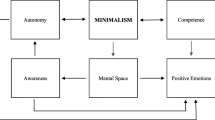Abstract
Lifestyle, currently a popular lay term but not an important construct within the social sciences, is examined briefly. Two studies designed to explore a lifestyle typology using personal projects methodology are reported. In the first study, three distinct lifestyle types were identified among a large community sample. They were tentatively labelled “pressured”, “relaxed”, and “wishful thinking” lifestyles. In the second stuty, these types were replicated for a university student group, with two types of a “relaxed” lifestyle being revealed.
Four lifestyle types were found among those in the university sample reporting high subjective well-being. They were tentatively labelled “hedonistic”, “adventuristic”, “individualistic”, and “promethean”. A preliminary analysis of a variety of demographic and socioeconomic variables using the four types for the subsample reporting high well-being revealed age and sex differences. Young respondents tended to be assigned to the hedonistic and adventuristic types, while older respondents tended to be assigned to the promethean type. Women tended to be assigned to hedonistic type. The results and some implications for further research are discussed.
Similar content being viewed by others
Bibliography
AdlerA.: 1930, ‘Individual psychology’, in C.Murchinson (ed.), Psychologies of 1930 (Clark University Press, Worcester).
AdlerA.: 1970, ‘Fundamentals of individual psychology’, Journal of Individual Psychology 26, 36–49.
BrinkerhoffM. B. and J. C.Jacob: 1986, ‘Quality of life in an alternative lifestyle: The smallholding movement’, Social Indicators Research 18, pp. 153–173.
Carroll, B.: 1983, ‘An exploration of the feasibility of a taxonomy of personal project systems’, unpublished B.A. honors thesis, Carleton University, Ottawa, Canada.
CoffinR. J. and M. W.Lipsey: 1981, ‘Moving back to the land: An ecologically responsible lifestyle change’, Environment and Behavior 13, pp. 42–63.
CostaP. T. and R. R.McCrae: 1980, ‘Influence of extraversion and neuroticism on subjective well-being: Happy and unhappy people’, Journal of Personality and Social Psychology 38, pp. 668–678.
DienerE.: 1984, ‘Subjective well-being’, Psychological Bulletin 95, pp. 542–575.
Friedman, M. and R. Rosenman: 1959, ‘Association of a specific overt behavior pattern with blood and cardiovascular findings’, Journal of the American Medical Association 169, p. 1286.
GroveP. B. (ed.): 1976, Webster's Third New International Dictionary of the English Language (Merriam, Springfield).
HorleyJ.: 1984, ‘Happiness, life satisfaction, and morale: Two problems with the use of subjective well-being indicators’, The Gerontologist 24, pp. 124–127.
HorleyJ.: 1987a, ‘The construal of events: Personal constructs versus personal projects’, in F.Fransella and L.Thomas (eds.), Experimenting with Personal Construct Psychology (Routledge and Kegan Paul, London).
Horley, J.: 1987b, Values, attitudes, and beliefs from a personal construct perspective. Paper to be presented at the Seventh International Congress on Personal Construct Psychology, Memphis, August.
HorleyJ. and B. R.Little: 1985, ‘Cognitive and affective components of global subjective well-being measures’, Social Indicators Research 17, pp. 189–197.
JenkinsC. D.: 1979, ‘The coronary-prone personality’, in W. D.Gentry and R. B.Williams (eds.), Psychological Aspects of Myocardial Infarction and Coronary Care (Mosby, St. Louis).
KellyG. A.: 1955, The Psychology of Personal Constructs (Vols. 1 and 2, Norton, New York).
KobasaS. C., HilkerR. R. S., and S. R.Maddi: 1979, ‘Who stays healthy under stress?’, Journal of Occupational Medicine 21, pp. 595–598.
LittleB. R.: 1972, ‘Psychological man as scientist, humanist, and specialist’, Journal of Experimental Research in Personality 6, pp. 95–118.
LittleB. R.: 1983, ‘Personal projects: A rational and method for investigation’, Environment and Behavior 15, pp. 273–309.
MitchellA.: 1983, The Nine American Lifestyles (MacMillan, New York).
MitchellJ. V.: 1984, ‘Personality correlates of life values’, Journal of Research in Personality 18, pp. 1–14.
MorrisC.: 1956, Varieties of Human Value (University of Chicago Press, Chicago).
PalysT. S. and B. R.Little: 1983, ‘Perceived life satisfaction and the organization of personal project systems’, Journal of Personality and Social Psychology 44, pp. 1221–1230.
PishkinV. and F. C.Thorne: 1979, ‘A comparative study of the factorial composition of responses on the life style analysis across clinical groups’, Journal of Clinical Psychology 31, pp. 249–255.
SheehyG.: 1976, Passages: Predictable Crises of Adult Life (New York, E.P. Dutton).
SkinnerH. A.: 1979, ‘The eyes that fix you: A model for classification research’, Canadian Psychological Review 18, pp. 142–151.
SkinnerH. A.: 1978, ‘The art of exploring predator-criterion relationships’, Psychological Bulletin 85, pp. 327–337.
SkinnerH. A.: 1979, ‘Dimensions and clusters: A hybrid approach to classification’, Applied Psychological Measurement 3, pp. 327–337.
SkinnerH. A. and H.Lei: 1980, Manual for Modal Profile Analysis (Addiction Research Foundation, Toronto).
SobelM. E.: 1981, Lifestyle and Social Structure: Concepts Definitions, Analysis (Academic, New York).
StrubeM. J., BerryJ. M., GozaB. K.,and D.Fermimore: 1985, ‘Type A behavior, age, and psychological well-being’, Journal of Personality and Social Psychology 49, pp. 203–218.
ThorneF. C.: 1975, ‘The life style analysis’, Journal of Clinical Psychology 31, pp. 236–240.
ThorneF. C. and V.Pishkin: 1975, ‘A factorial study of needs in relation to lifestyles’, Journal of Clinical Psychology 31, pp. 240–248.
VeenhovenR.: 1984, Conditions of Happiness (D. Reidel Publishing, Dordrecht).
ZablockiB. D. and R. M.Kanter: 1976, ‘The differentiation of life-styles’, Annual Review of Sociology 2, pp. 269–298.
Author information
Authors and Affiliations
Additional information
This paper is based on the presentation by J. Horley and B. Carroll, “Values, lifestyles and personal project profiles”, at the 45th Annual Meeting of the Canadian Psychological Association, Ottawa, June, 1984. Appreciation is due to Dr. Harvey Skinner for this comments on an early version of this paper, and to Dr. Linda Wood for her helpful critique of a later version of the manuscript.
Rights and permissions
About this article
Cite this article
Horley, J., Carroll, B. & Little, B.R. A typology of lifestyles. Soc Indic Res 20, 383–398 (1988). https://doi.org/10.1007/BF00302334
Received:
Issue Date:
DOI: https://doi.org/10.1007/BF00302334




